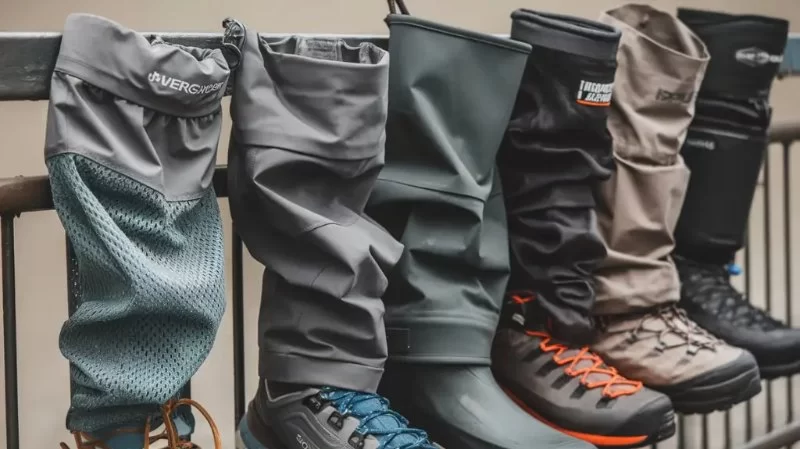- why-hiking-gaiters-are-essential-for-outdoor-protection
- factors-to-consider-when-choosing-the-right-hiking-gaiters-for-protection
- matching-gaiters-to-the-type-of-hike
- real-hiking-stories-where-gaiters-made-the-difference
- where-to-find-quality-gaiters-and-trail-tested-advice
1. Why Hiking Gaiters Are Essential for Outdoor Protection
When exploring rugged trails, wet terrain, or bush-covered routes, it’s not just your boots that need attention—your lower legs do too. That’s where gaiters come in. The benefits of choosing the right hiking gaiters for protection go far beyond comfort. Gaiters act as a shield against thorns, mud, snow, rocks, leeches, and even ticks. They bridge the vulnerable space between your boots and your pants, helping you stay dry, clean, and safe.
Especially in areas where weather can shift or where trails are unpredictable, a good pair of gaiters can keep a hike from turning into a miserable slog. They’re lightweight, easy to pack, and often the difference between finishing strong or heading back early.
2. Factors to Consider When Choosing the Right Hiking Gaiters for Protection
2.1 Material Durability and Breathability
Look for gaiters made from abrasion-resistant nylon or polyester. For alpine and mountaineering hikes, heavier-duty materials like Gore-Tex offer waterproof protection while remaining breathable. In warmer climates, a lighter fabric will keep debris out without overheating your legs.
2.2 Height and Fit
Gaiters come in ankle, mid-calf, and knee-high lengths. If you’re hiking in muddy or snowy conditions, opt for the taller ones. For trail runners or desert hikers, a low-profile gaiter that fits snugly around the ankle is usually sufficient. Proper fit is key—too loose and they’ll sag, too tight and they’ll restrict movement.
2.3 Closure and Fastening Systems
Velcro, zippers, and snap buttons are all common closure systems. The best ones offer easy adjustment and a secure hold, even after hours on the trail. A strong underfoot strap, preferably made of coated nylon or reinforced TPU, will prevent the gaiter from riding up as you hike.
3. Matching Gaiters to the Type of Hike
3.1 For Snow and Alpine Treks
In snow-covered environments or icy routes, knee-length waterproof gaiters with sealed seams are a must. They keep snow from entering your boots and help retain warmth. For example, when trekking around Mount Kinabalu’s higher altitudes, many climbers reported soaked boots without gaiters but dry and warm feet with them.
3.2 For Forest and Jungle Trails
Dense vegetation and leeches are common on Southeast Asian trails. Mid-calf gaiters treated with insect-repelling coating work well here. They also protect against thorn scratches and dirt, especially in wet monsoon conditions.
3.3 For Desert and Dry Terrain
Desert hikers need lightweight gaiters to keep out sand, small rocks, and seeds. Breathability is more important than waterproofing here. Ankle gaiters with elastic cuffs and secure boot hooks prevent debris buildup without overheating.
4. Real Hiking Stories Where Gaiters Made the Difference
4.1 Escaping a Storm in Colorado
Lena, an avid solo backpacker, recounted a thunderstorm rolling in fast during a hike near Colorado’s San Juan Mountains. Her gaiters kept rain and mud out of her boots as she descended in a rush. “I didn’t even think about them until I saw others wringing out socks at the bottom,” she said. “Mine stayed dry.”
4.2 Leeches in the Malaysian Highlands
A group of hikers tackled the Cameron Highlands and quickly realized the trail was swarming with leeches. One hiker, Alex, had packed gaiters he almost didn’t wear. “They saved me. I took them off at camp and found five leeches stuck to the outside—none got through.”
4.3 Sandstorms in the Sahara
During a guided trek in Morocco, a traveler named Pierre shared how his lightweight gaiters kept fine sand out of his boots during two unexpected sandstorms. “Other people had to stop and empty their shoes every hour. I didn’t.”
5. Where to Find Quality Gaiters and Trail-Tested Advice
Finding the right pair of hiking gaiters can feel overwhelming with so many options. The key is to match the product to the terrain, climate, and personal comfort preferences. Whether you're trekking through forests, deserts, snow, or unpredictable terrain, investing in gaiters tailored to your needs is a decision you’ll thank yourself for.
At Pine Cliff Resort, we don’t just offer serene hiking getaways—we provide gear guidance too. Our on-site store and online platform feature trail-tested gaiters recommended by guides and frequent hikers. Whether you’re preparing for a weekend loop or a full expedition, our experts can help you pick the best gaiters to stay protected and comfortable every step of the way.







